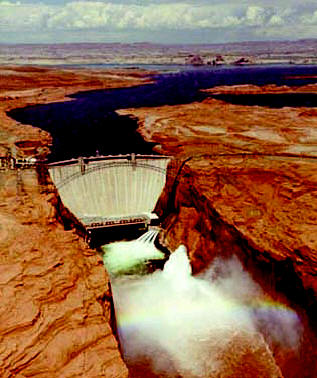
glen canyon instituteDedicated to the restoration of Glen Canyon and a free flowing Colorado River.
GCI
Lake Powell Reservoir
A Failed Solution
Lake Powell reservoir was justified to Congress in the 1950s as the perfect solution to water supply uncertainty in the growing southwest. It was to be the “silver bullet”, providing an insurance policy for the upper basin states’ annual water delivery requirement, regulating floods, and acting as a “cash register” hydropower dam with the funds generated then being used to pay for the construction of dozens of other dams and irrigation projects upstream in the Colorado’s watershed. After half of a century, it is clear that Lake Powell reservoir is far from the perfect solution to the water supply problems in the West.
Lake Powell: Unnecessary for Water Delivery
Built for political purposes, the original goal of Glen Canyon Dam was water security; that is, water storage to ensure delivery to the Lower Basin and protection of  the water dowry of the Upper Basin states. The upper basin is required to deliver 8.23 million acre-feet (MAF) of Colorado River water to the lower basin and Mexico every year. The writers of the 1922 Colorado River Compact based the annual delivery requirement on a ten-year average to allow for annual fluctuations in river flow. However, we now know that annual delivery requirements were based on flawed projections suggesting that annual river flow was equal to 16.5 MAF annually. More than eighty years since the Compact was signed, the average annual flow has proven to be closer to 13.5 MAF. Losing another 1 MAF of water at Powell reservoir each year, the basin is left to satisfy the water demands of 16.5 MAF with 12.5 MAF. The Western water delivery system is inefficient and it is only a matter of time before it fails completely.
the water dowry of the Upper Basin states. The upper basin is required to deliver 8.23 million acre-feet (MAF) of Colorado River water to the lower basin and Mexico every year. The writers of the 1922 Colorado River Compact based the annual delivery requirement on a ten-year average to allow for annual fluctuations in river flow. However, we now know that annual delivery requirements were based on flawed projections suggesting that annual river flow was equal to 16.5 MAF annually. More than eighty years since the Compact was signed, the average annual flow has proven to be closer to 13.5 MAF. Losing another 1 MAF of water at Powell reservoir each year, the basin is left to satisfy the water demands of 16.5 MAF with 12.5 MAF. The Western water delivery system is inefficient and it is only a matter of time before it fails completely.
**Note The earliest official government flow records from 1906-2003, demonstrate that without Glen Canyon Dam, the upper basin would have been able to deliver the Compact required 75 MAF to the lower basin and Mexico in every single ten-year period on the record.
Lake Powell: A Huge Water Waster
Due to its high desert location and huge surface area, Lake Powell loses an average of 860,000 AF of water annually to evaporation and bank seepage. Glen Canyon Dam is unnecessary and counterproductive to the water storage and delivery purposes for which it was built. Each year, enough water is wasted by the dam to supply the entire City of Los Angeles. That’s three times Nevada’s annual allotment and enough to supply the Salt Lake Valley for five years. It essentially serves as a water meter to measure the upper basin’s delivery to the lower basin. However, it is a “leaky faucet” which makes delivering that water more difficult for the upper basin.
- Lake Powell loses more than 6% of the Colorado River’s annual flow — more than three times Nevada’s annual allotment.
- Since completion of the Dam, more than 34 MAF of Lake Powell water has been lost to evaporation and bank storage.
- The water lost is Upper Basin water: Glen Canyon Dam actually makes it more difficult to fulfill the delivery requirement of 8.23 MAF of water to the Lower Basin.
Based upon the Bureau’s own historical flow data (1906-2002), with water wasting Powell reservoir, there is a 1:1000 chance the Upper Basin would be unable to deliver the required 8.23 MAF of water. Without the water loss at Lake Powell, the odds decrease to 1:30,000.
The Economic Perspective
As the demand for water in the Southwest steadily grows, the utility of a reservoir that wastes nearly 1 MAF every year is suspect. In San Diego water prices – based upon the price used in the ongoing negotiations for the sale of Colorado River water by the Imperial Irrigation District to San Diego – the water lost at Lake Powell each year is worth $225 million dollars. The fair market value of the water wasted by Glen Canyon Dam is far greater than the net income from the sale of electricity produced by the dam; essentially, the “fuel” costs more than the product being produced. Since 1963, more than 34 MAF of water has been lost from Lake Powell; worth about $9 billion.
Drought & Climate Change 
To further complicate water supply concerns, recent scientific studies predict the water supply in the West to be reduced drastically over the next few decades. By 2050, University of Washington scientists predict the flow of the Colorado River to decline by one third. During the past decade of drought, many scientists studying tree ring evidence suggest that the West is actually experiencing a return to normal drier climate conditions.
In reality we may be reentering a low water period that has not been seen for the last 500 years. If the predictions of climate models are correct, the Colorado River water supply will continue to decrease. It is imperative for the sustainability of the West that our current inefficient water management system be altered. As the most destructive and least useful water project ever constructed, operation methods at Glen Canyon Dam must be re-evaluated. It is the duty of water managers in the West to secure a sustainable system for the Colorado Basin of the future.